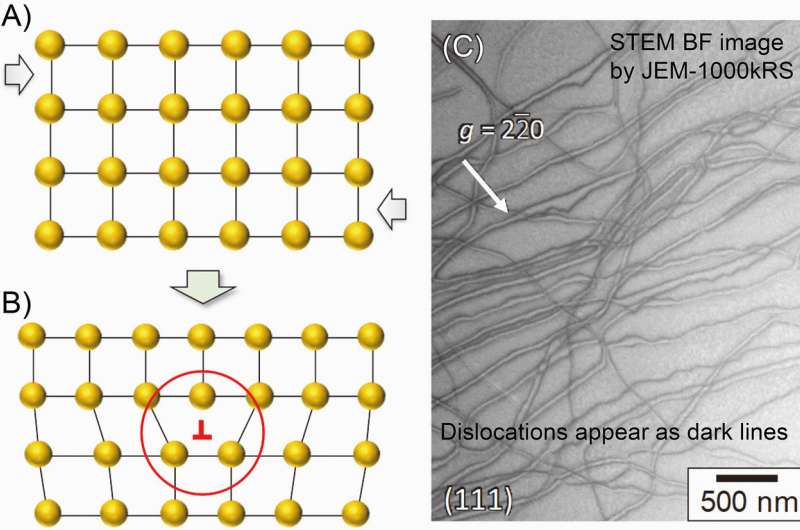Keep the light off: A material with improved mechanical performance in the dark
![Inorganic semiconducting crystals generally tend to fail in a brittle manner. This is true for zinc sulfide (ZnS); ZnS crystals (A) show catastrophic fracture after mechanical tests under ordinary light-exposure environments (B). However, we found out that ZnS crystals can be plastically deformed up to a deformation strain of εt = 45 % when deformed along the [001] direction in complete darkness even at room temperature (C). Moreover, the optical band gap of the deformed ZnS crystals decreased by 0.6 eV after deformation. Credit: Atsutomo Nakamura Keep the light off: A material with improved mechanical performance in the dark](https://scx1.b-cdn.net/csz/news/800a/2018/keepthelight.jpg)
Inorganic semiconductors such as silicon are indispensable in modern electronics because they possess tunable electrical conductivity between that of a metal and that of an insulator. The electrical conductivity of a semiconductor is controlled by its band gap, which is the energy difference between its valence and conduction bands; a narrow band gap results in increased conductivity because it is easier for an electron to move from the valence to the conduction band. However, inorganic semiconductors are brittle, which can lead to device failure and limits their application range, particularly in flexible electronics.
A group at Nagoya University recently discovered that an inorganic semiconductor behaved differently in the dark compared with in the light. They found that crystals of zinc sulfide (ZnS), a representative inorganic semiconductor, were brittle when exposed to light but flexible when kept in the dark at room temperature. The findings were published in Science.
"The influence of complete darkness on the mechanical properties of inorganic semiconductors had not previously been investigated," study co-author Atsutomo Nakamura says. "We found that ZnS crystals in complete darkness displayed much higher plasticity than those under light exposure."
The ZnS crystals in the dark deformed plastically without fracture until a large strain of 45%. The team attributed the increased plasticity of the ZnS crystals in the dark to the high mobility of dislocations in complete darkness. Dislocations are a type of defect found in crystals and are known to influence crystal properties. Under light exposure, the ZnS crystals were brittle because their deformation mechanism was different from that in the dark.

The high plasticity of the ZnS crystals in the dark was accompanied by a considerable decrease in the band gap of the deformed crystals. Thus, the band gap of ZnS crystals and in turn their electrical conductivity may be controlled by mechanical deformation in the dark. The team proposed that the decreased band gap of the deformed crystals was caused by deformation introducing dislocations into the crystals, which changed their band structure.
"This study reveals the sensitivity of the mechanical properties of inorganic semiconductors to light," coauthor Katsuyuki Matsunaga says. "Our findings may allow development of technology to engineer crystals through controlled light exposure."
The researchers' results suggest that the strength, brittleness, and conductivity of inorganic semiconductors may be regulated by light exposure, opening an interesting avenue to optimize the performance of inorganic semiconductors in electronics.
More information: Y. Oshima el al., "Extraordinary plasticity of an inorganic semiconductor in darkness," Science (2018). science.sciencemag.org/cgi/doi … 1126/science.aar6035
Journal information: Science
Provided by Nagoya University




















